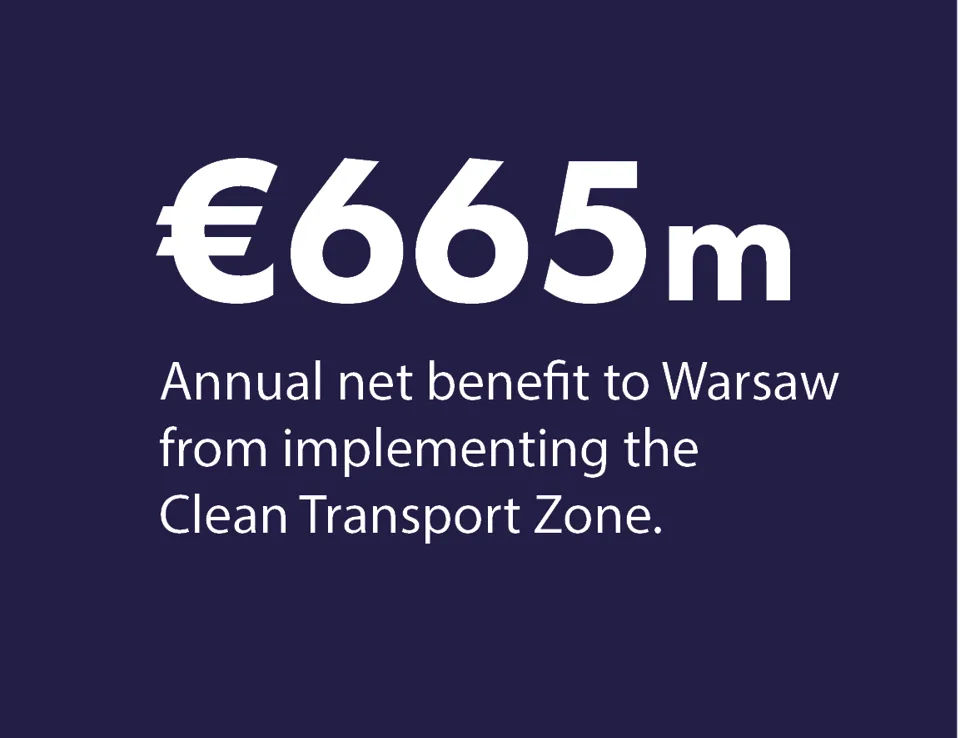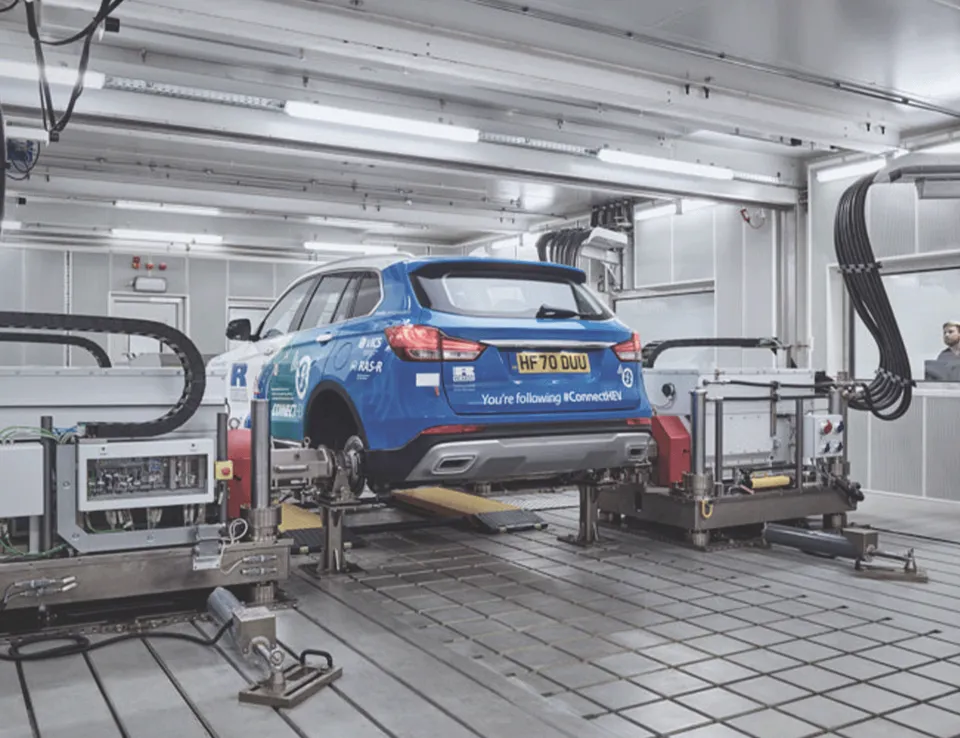Warsaw's groundbreaking Clean Transport Zone
Clear evidence from Ricardo's experts about the health and economic benefits of tackling transport emissions has resulted in the City of Warsaw voting to adopt the city’s first ever Clean Transport Zone in July 2024.
Warsaw's Clean Transport Zone will include the city centre and parts of the central districts: an area of 37 square kilometres or seven percent of the capital’s area.
But what are clean transport zones, how effective are they, and what positive impacts on health and economic benefit can they make? Ricardo Air Quality expert, Thomas Adams, whose research and analysis played a pivotal role in founding the Clean Transport Zone shares his insights.
Q: Why is improving air quality so important for the City of Warsaw?
Tom: “Air pollution is the most important environmental health risk of our time. Clean air is not a luxury – it is a human necessity. As internationally renowned air quality experts, we are proud that our analysis has provided compelling evidence for members of the public, businesses and the authorities alike in Warsaw to be able to make informed decisions and take ambitious actions to improve air quality in their city.”
Q: What are the key expected health economic benefits of the scheme for Warsaw?
Tom: “We estimated that implementing the Clean Transport Zone in the city could deliver an annual net benefit to Warsaw society valued at 665 million euros (2.9 billion zloty): 12% of the city’s annual budget. Greenhouse gas emission reductions are estimated at 756 kilotonnes. Putting a price on health impacts, taking into account mortality rates, morbidity effects, savings in healthcare costs, avoiding lost productivity and the value placed on good health and wellbeing, the overall value of air pollution benefit on human health is estimated at 330 million euros annually.”
Q: What is a Low Emission Zone/Clean Transport Zone and what is the purpose of this assessment?
Tom: “Low Emission Zones (LEZs) or, as they are called in Poland, Clean Transport Zones (in Polish: Strefy Czystego Transportu, SCT), are a defined area within a town or city where access by some polluting vehicles is restricted or deterred. LEZs are implemented with the aim of improving air quality and helping to protect public health. As more LEZs are implemented across Europe, towns and cities are rightly performing consultations to help them to better understand the impacts of different LEZ schemes to select the most appropriate option for their urban area.”
Q: What Low Emission Zone/Clean Transport Zone assessment did Ricardo experts undertake for the City of Warsaw?
Tom: “We provided an assessment of the impacts of different LEZ options so that the city authority, businesses and the public had clear evidence on the costs and benefits for adopting a preferred scheme.”
Q: How effective are Low Emission Zones?
“In urban areas, concentrations of nitrogen dioxide (NO2) and particulate matter (PM2.5 and PM10, microscopic solids or liquid droplets that are so small that they can be inhaled) can be particularly high. LEZs are one measure which local authorities can implement to try and lower pollutant concentrations to safer levels. LEZs are areas implemented where the most polluting vehicles are restricted or deterred and this usually means that vehicles with higher emissions cannot enter the area.”
“We modelled two of the phases of LEZ implementation, these were Phase 2 – with a minimum standard of Euro 3 Petrol (vehicles 26 years old or older), Euro 5 Diesel (vehicles 17 years old or older); and Phase 3 – Euro 4 Petrol (vehicles 21 years old or older), Euro 6 Diesel (vehicles 12 years old or older). The restricted vehicles tend to be the older, most polluting cars, vans and heavy vehicles.”
“The success of LEZs depends on multiple factors including their scale (eg geographical area and level/type of restrictions) and the main sources of pollutants in the location such as transport, domestic combustion and industry. LEZs are not the same everywhere making them hard to compare. For example, some apply to lorries and buses only, while others also include taxis, cars and motorcycles.”
“Our report showed that the Warsaw LEZ is very good at reducing instances where the European annual limit value for NO2 is exceeded. The LEZ does also reduce concentrations of particulates but the impact is much less significant than for NO2, since transport exhaust emissions are a smaller contributor to particulate matter than they are to nitrogen oxides (NOx).”

Pollutant emissions and concentrations
Tom: “The sources of direct emissions of air pollutants in Warsaw include but are not limited to: road transport, other transport - such as rail - household heating and industrial processes.
The most important source of emissions will also vary from pollutant to pollutant. The relationship between emissions at source and concentrations of air pollutants in the air that we breathe is not straightforward and is impacted by factors including the weather, transboundary movement (ie from sources outside the city) and secondary formation of pollutants (ie chemical reactions).”
“This means that a reduction in transport emissions does not translate to the same reduction in air pollution concentrations, as other sources will also contribute, and dispersion and chemistry also play a role. As a result, it is important to measure and model ambient air quality as a result of a scheme in addition to quantifying emissions. The modelling of pollutant concentrations also enables comparison of the LEZ scheme impacts against the legally binding EU air quality limit values.”
We supported a multinational consumer goods company to assess alternatives for their diesel-powered refrigerated trailers. These refrigerated trailers have a significant environmental impact and so switching trailers onto alternative fuels can significantly improve a fleet’s emissions.
While power take off (PTO) (taking energy from the tractor battery) works well for rigid trucks, articulated trucks do not yet have standardised high-power connections between the tractor and trailer, and tractor range is reduced. Alternatively, a transport refrigeration unit (TRO) gives the trailer “autonomy”, but it adds cost, reduce the payload and means that the trailers need to be charged, which complicates logistics.
Beyond refrigerated transport, Ricardo has experience supporting other specialist vehicle fleets, including waste, emergency services and military.
Q: What are the EU air quality standards and why did Ricardo’s assessment compare against them?
Tom: “The EU air quality standards are legally binding limit values for concentrations of major air pollutants that impact public health across Europe. In 2022, of the three automatic monitoring locations within the proposed LEZ boundary, the City of Warsaw had one measured exceedance of the European annual limit value for NO2 and one location identified as at risk of exceeding (within 10% of) the limit value. Two locations were also observed as being within 10% of the limit value for PM2.5.”
Q: What vehicle emissions standard restrictions for the LEZ were assessed?
Tom: “The proposal is for a phased LEZ introduction with standards tightening over time. We modelled two of the phases: Phase 2 – with a minimum standard of Euro 3 Petrol (vehicles 26 years old or older), Euro 5 Diesel (vehicles 17 years old or older); and Phase 3 – Euro 4 Petrol (vehicles 21 years old or older), Euro 6 Diesel (vehicles 12 years old or older). The vehicle age was calculated at time of scheme implementation in 2026.”
Q: Why did you assess the impacts in 2026?
Tom: “The difference between the two phases was judged likely to be significant. Modelling them both in 2026 allowed them to be directly compared and also indicated the impact and practicality of bringing the more stringent standards in at an earlier date.”
Q: What is the predicted impact of the LEZ on air quality in Warsaw?
Tom: “The LEZ is very effective at reducing exceedances of the European NO2 annual limit value, with Phase 3 (Euro 4 Petrol, Euro 6 Diesel) removing all exceedances at monitoring locations within the zone itself. While the LEZ does also reduce concentrations of particulates, however the impact is much less significant than for NO2, since transport exhaust emissions are a smaller contributor to particulate matter than they are to nitrogen oxides (NOx). Other policies such as restrictions on the use of solid fuel burning to heat homes would likely be more effective at reducing PM concentrations.”
Q: What health impacts were assessed?
Tom: “Our assessment provided estimates of the air pollution related health impacts of LEZ implementation. This included the change, as a result of the LEZ, in the number of deaths, life expectancy, years of lost life, and number of hospital admissions. The impacts captured in the assessment included: mortality associated with long-term exposure; respiratory hospital admissions associated with acute exposure; cardiovascular hospital admissions associated with acute exposure; chronic bronchitis; ischaemic heart disease; stroke; lung cancer; asthma in both adults and children; and diabetes.”
Q: How were health impacts assessed?
Tom: “Changes in concentrations from the air quality assessment and concentration response functions (CRFs, statistical estimates of the relationship between exposure to pollutants and health outcomes) were combined with Warsaw population and baseline health data to estimate the impact of the LEZ on public health in Warsaw.”
Q: What was included in the cost benefit analysis?
Tom: “We deployed cost benefit analysis to demonstrate the value for money of the different LEZ options. Our assessment included the costs and benefits of nine key factors: health impacts; vehicle upgrades; residual value of scrapped vehicles; change in fuel use; change in non-fuel vehicle operating costs; welfare impact of cancelled trips; change in travel time; greenhouse gas emissions; implementation costs.”
Q: Where did the cost benefit data come from?
Tom: “We used data from Warsaw and Poland where possible. Any gaps were filled using appropriate European values.”
Q: What is the Benefit:Cost ratio?
Tom: “This is used to compare the total monetised benefits of implementing the LEZ against the costs. A positive value means that the benefits of implementing the LEZ outweigh the costs.”
Q: What is net present value?
Tom: “The net present value is the difference between the annual benefits and costs valued in a given year: in this case 2023. Again, a positive value means that the benefits of implementing the LEZ outweigh the costs.”

Tackling air pollution for over 60 years
Ricardo has the longest-established specialist air quality team in the world and, with over two hundred experts, we are the largest and longest established air pollution consultancy in Europe.
We proudly trace our heritage to work in the UK that followed the infamous London smogs of the 1950s, which were found to be responsible for at least 12,000 deaths. These smogs led to UK government action through far-reaching air pollution controls and the seminal UK Clean Air Act of 1956.
Over the last 60 years our experts have continued to provide trusted advice, helping governments, city authorities and businesses across the globe to understand and manage air pollution.









